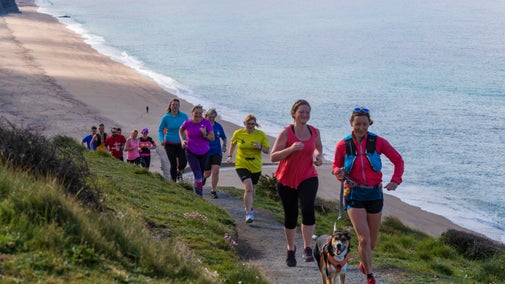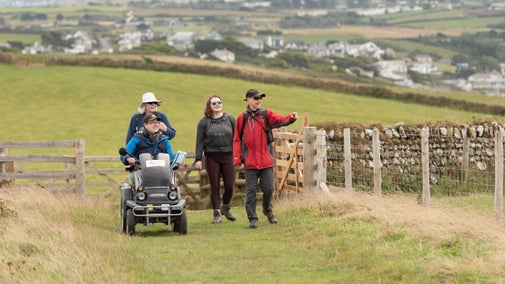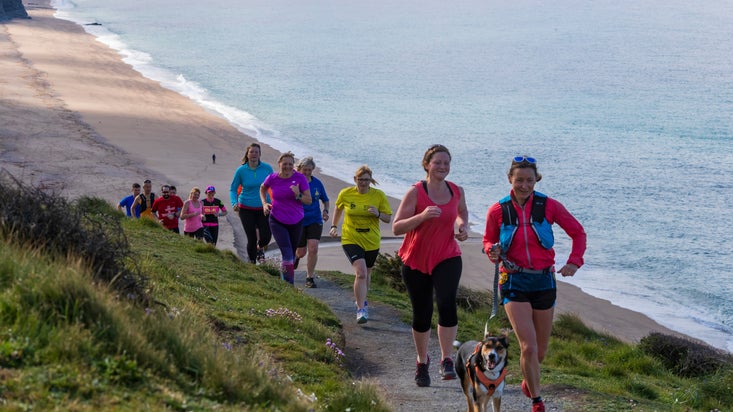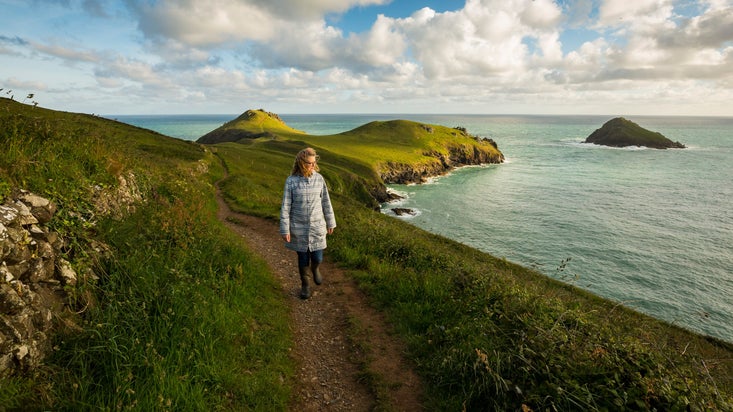
Become a member
Join today and help protect nature, beauty and history – for everyone, for ever. Enjoy access to more than 500 places with National Trust membership.
Pentire is an exceptionally beautiful headland with far reaching views and managed for wildlife.
Pentire, near Wadebridge, Cornwall, PL27 6QY

| Asset | Opening time |
|---|---|
| Pentire | Dawn - Dusk |
| Pentyr Café | 10:00 - 15:00 |
Toilet only open when Pentyr Café is open over the winter
| Ticket type | With Gift Aid | Without Gift Aid |
|---|---|---|
| Whole day | £9.00 |
Small selection of second-hand books for sale in the indoor seating barn
Café with outdoor, undercover and indoor seating (with a wood burning stove) next to the main car park at Pentireglaze. There is also a sensory orchard for picnics and play.
Open dawn until dusk. Main car park at Pentireglaze (PL27 6QY) where you'll find the toilets and café, with small car parks at Lead Mines and Lundy Bay. No overnight camping or parking.
There is a cycle rack in the main car park at Pentireglaze
Dogs welcome under control, particularly around livestock and cliff edges. Dogs are prohibited from Pentireglaze Haven beach from 10am-6pm, 15 May-30 September.
Four 11kW electric vehicle charging points are available in the main car park at Pentireglaze. Chargers can be accessed using mobile app, RFID card, or contactless payment device. Visit our EV charging provider RAW Charging’s website (www.rawcharging.com/drivers) to download the app in advance of your visit.
There are picnic tables in the sensory orchard
Toilets with separate baby changing facilities next to the car park at Pentireglaze. Toilets only open when the café is open over the winter.
Blue Badge parking. Accessible toilet and Changing Places. Café and welcome building accessible. Tramper. Accessible paths to orchard (nest swing).
There are numerous accessible paths, including to the orchard and wider headland. Please speak with someone from the Welcome Team for more information about routes available or email us ahead of your visit.
Limited winter opening, but the Changing Places (which also has an accessible toilet) can be accessed with a RADAR key any time
Fully fitted Changing Places, accessible any time with a RADAR key or speak with a member of staff
There is an induction loop at the café and for Tramper hire
Tramper (all terrain mobility scooter) available to use (Fri-Sun over the winter). Please email pentiretramper@nationaltrust.org.uk to check availability and to book.
There is a ramp to access the café servery and inside the indoor seating area. There is a sensory orchard for picnics and play accessed by an even but sloping path.
Accessible picnic tables available in the courtyard and orchard. Bench seating at various points on the headland.
Beyond the immediate visitor welcome area at Pentireglaze (where the car park, toilets, café and orchard are located) there are footpaths that can be uneven and there are steps and kissing gates.
Main car park at Pentireglaze - what3words: ///mixture.curly.exotic

All you need to know about visiting Pentire with children, including October family fun.

See what events are happening at Pentire.

Whether you're grabbing some refreshments from Pentyr Café or bringing a picnic to enjoy, there are lots of options on where you can eat at Pentire.

Visitors with limited mobility can now explore more coastline at Pentire headland. Email pentiretramper@nationaltrust.org.uk to find out how you can hire a Tramper mobility scooter at Pentire headland.

Here you'll find out about accessibility at Pentire and how to make the most of your visit.

Pentire is a two pawprint rated place. Bring your dog to this stretch of Cornish coastline for fresh-air fun, with lots of walks to choose from, perfect for four paws (and two legs).

Help to look after National Trust places by observing a few simple guidelines during your visit and following the Countryside Code.

A distinctive stretch of coast, once an Iron Age settlement, reached by coastal paths.
Tip of the headland, with views across Padstow Bay and boasting an abundance of wild flowers and birds.
A sandy cove at low tide with rock pools which is a 20-minute walk from the car park.
Accessible to buggies and wheelchairs; a space to picnic and for natural play. Nest swing and children’s trail.
Café with courtyard, undercover and indoor seating (with wood burner). Serving pasties, light lunches, cake, cream teas and ice cream.
The Trust10 is a monthly trail run that gives you the opportunity to explore Pentire headland whilst enjoying a challenging run.


Discover this dramatic stretch of Cornish coastline just north of Polzeath, whether you want to get active outdoors, or simply sit and soak up the views.

All you need to know about visiting Pentire with children, including October family fun.

Whether you're grabbing some refreshments from Pentyr Café or bringing a picnic to enjoy, there are lots of options on where you can eat at Pentire.

Enjoy a walk that takes in the spectacular Pentire Point and the Rumps. The circular route starts at the main car park at Pentireglaze where there are toilets and a café (check for opening).

A circular walk at Pentire headland with an abundance of wild flowers and birds to spot, as well as clifftop views of the Rumps. There are toilets and a café at Pentireglaze, part way along the route.

Just a mile or so before you reach New Polzeath, there's a sheltered valley where light woodland and scrub lead to a gem of a rocky bay, with sandy coves at low tide.

Discover this circular walk along the clifftops of the South West Coast Path, taking in Lundy Bay, Port Quin and views of Doyden Castle and the Rumps headlands.

Walk through farmland and along the South West Coast Path for clifftop views across Padstow Bay and opportunities to swim, rockpool and spot wildlife. There is a café and toilets by the main car park.


A cosy two bedroom cottage on the north coast of Cornwall with views of the ocean and towards Polzeath.

A handsome Cornish farmhouse with space to gather, perched on the Pentire headland for beaches, walking trails and wildlife.

Forming one half of a beautifully restored historic farmhouse on the wildlife-filled Pentire headland, there’s sea views for miles from this truly special spot.

One of the best cottages to stay for scenic walks with the north Cornwall coast in sight.

A spacious, rural cottage with lots of original features and views to the Stepper Point lighthouse.

Surround yourself with farmland and countryside views in this rural cottage, just a 10-minute stroll to the sandy beach of Pentireglaze Haven.

A simple Victorian farmworker's cottage with far-reaching sea views from the garden.
Our popular, resident wooden reindeer herd are back out of hibernation with a fun new trail for 2025. This time they have brought some youngsters with them.
The Trust10 is a monthly trail run that gives you the opportunity to explore Pentire headland whilst enjoying a challenging run.
Join us in a traditional ceremony to awaken the cider apple trees to ensure a fruitful harvest in the autumn.
Overlooking Polzeath, a popular North Cornwall holiday destination, Pentire headland has been inhabited by humans since 4000BC but remains mostly undeveloped and a coastal escape for visitors.
The remnants of Iron Age ramparts can be seen at the Rumps and the scars of silver-lead mining are etched over the headland.
Our relationship with the land continues and today we are farming for the benefit of nature, supporting the abundance of wildflowers and a variety of wildlife and birds that have made Pentire their home.
Accessible routes over the headland offer spectacular views of the coast and countryside.
See how the way we work with the farm at Pentire is designed to benefit all kinds of wildlife, so there’s more for you to enjoy when you visit.

We are working to create 250 hectares of new species rich grassland at National Trust sites across Cornwall. The project, due to be completed by 2026, will help us rise to the twin challenges of biodiversity loss and climate change.
Find out about the fascinating history of Pentire headland, dating back to the Neolithic period.

Search for live volunteering opportunities, or register your interest with Pentire.


Join today and help protect nature, beauty and history – for everyone, for ever. Enjoy access to more than 500 places with National Trust membership.
By sharing your email address you’re agreeing to receive marketing emails from the National Trust and confirm you’re 18 years old or over. Please see our for more information on how we look after your personal data.